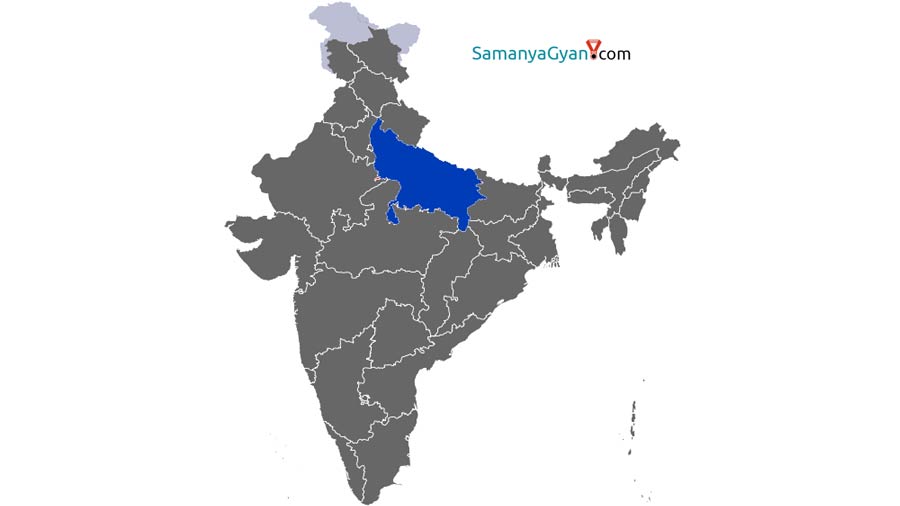Through this chapter, we will know the detailed and important information of Uttar Pradesh, in which important and interesting information like history, geography, economy, education, culture and world famous tourist places located in the state have been added. Apart from this, the recent developments and changes in the state of Uttar Pradesh have also been explained in detail. This chapter is full of interesting facts for the competitive aspirants as well as the readers.
Quick General Knowledge
| State Level | State |
| Capital | Lucknow |
| Statehood | 26 January 1950 |
| Largest City | Kanpur |
| Total Area | 2,43,286 sq km |
| Districts | 75 |
| Current Chief Minister | Yogi Adityanath |
| Current Governor | Anandiben Patel |
| State Bird | Sarus crane |
| State Flower | Palash |
| State Animal | Barasingha |
| State Tree | Ashoka tree |
| Languages | Hindi, Urdu |
| State Dance | Nautanki, Raslila, Kajri, Jhora, Chappeli and Jaita. |
Uttar Pradesh (उत्तर प्रदेश)
Uttar Pradesh is a state located in the northern direction of India. Uttar Pradesh is the largest state in India by population. The capital of Uttar Pradesh is Lucknow. Kanpur is the largest city in Uttar Pradesh. Only five nations of the world, China, India, United States, Indonesia and Brazil have more than the population of Uttar Pradesh. The main court here is located in Allahabad.
Currently, there is a Bharatiya Janata Party government in Uttar Pradesh. The current Chief Minister of Uttar Pradesh is Yogi Adityanath. He was sworn in as the 21st Chief Minister of the state on 19 March 2017. The first person to become the Chief Minister of Uttar Pradesh was Govind Ballabh Pant. He was sworn in as the Chief Minister of the state on 26 January 1950.
The current Governor of Uttar Pradesh is Anandiben Patel. He is sworn in as the Governor of Uttar Pradesh on 29 July 2019. Sucheta Kripalani became the first woman Chief Minister of Uttar Pradesh and India in the year 1963.
The members of Lok Sabha and Rajya Sabha are elected the most from Uttar Pradesh. The state has 80 seats in the Lok Sabha and 31 seats in the Rajya Sabha. There are a total of 403 assembly seats in the state.
- There are 75 districts and 18 divisions in Uttar Pradesh.
- Uttar Pradesh is the state with the most districts in the country.
- The largest district of Uttar Pradesh is Allahabad (by population), while Kushinagar (by area) is the largest district.
- Sonbhadra district of Uttar Pradesh is the only district in the country whose boundaries touch four states.
Following are 75 districts of Uttar Pradesh: - Ambedkar Nagar, Amethi, Aligarh, Agra, Azamgarh, Etawah, Allahabad, Unnao, Etah, Auraiya, Kannauj, Kanpur Dehat, Kanpur Nagar, Kasganj, Kushinagar, Kaushambi, Ghaziabad, Ghazipur, Gonda, Gorakhpur, Gautam Buddha Nagar, Chandauli, Chitrakoot, Jalaun, Jaunpur, Jyotiba Phule Nagar, Jhansi, Deoria, Pilibhit, Pratapgarh, Fatehpur, Farrukhabad, Firozabad, Faizabad, Badaun, Bareilly, Balrampur, Ballia, Basti, Basti, Bahraich, Bahraich, Bahraich Baghpat, Barabanki, Bijnore, Bulandshahr, Mau, Mathura, Maharajganj, Mahoba, Mirzapur, Muzaffar Nagar, Moradabad, Meerut, Mainpuri, Rampur, Rae Bareli, Lucknow, Lakhimpur Kheri, Lalitpur, Varanasi, Shamli, Shahjahanpur, Sant Kabir Nagar, Sant Ravid Nagar, Sant Ravi Nagar Nagar, Sambhal, Saharanpur, Siddharth Nagar, Sitapur, Sultanpur, Sonbhadra, Hamirpur, Hardoi, Hathras and Hapur.
- The Gross State Domestic Product of Uttar Pradesh grew at a CAGR of around 8.43% between 2015-16 and 2020-21 to reach Rs. 17.06 trillion. The Net State Domestic Product (NSDP) grew at a CAGR of around 8.42% between 2015-16 and 2020-21 to reach Rs. 15.12 trillion.
- Uttar Pradesh is a favored tourist destination in India with Taj Mahal, one of the eight Wonders of the World, located in Agra. In 2019, domestic tourist arrivals in the state reached 535.8 million. Foreign tourist arrivals crossed over 4.74 million.
- As of April 2021, Uttar Pradesh had an installed power generation capacity of 28,001.95 MW—6,242.20 MW (state utilities), 13,562.74 MW (private utilities) and 8,197.01 MW (central utilities).
- In June 2021, Greenply Industries announced that it will invest around Rs. 75 crore to set up plywood and allied products manufacturing unit at Sandila Industrial Area in Hardoi, Uttar Pradesh.
- In January 2021, the state government announced its plan to build 1,038 new Ganga aarti platforms along the river in Bijnor and Ballia districts.
- Allahabad Fort Uttar Pradesh History and Interesting Facts
- Taj Mahal Uttar Pradesh History and Interesting Facts
- Akbars Tomb Uttar Pradesh History and Interesting Facts
- Buland Darwaza Fatehpur Sikri Uttar Pradesh History and Interesting Facts
- Bara Imambara Uttar Pradesh History and Interesting Facts
- Itmad Ud Daulah Agra Uttar Pradesh History and Interesting Facts
- Agra Fort Uttar Pradesh History and Interesting Facts
- Prem Mandir Vrindavan Uttar Pradesh History and Interesting Facts
- Jhansi Fort Uttar Pradesh History and Interesting Facts
- Fatehpur Sikri Uttar Pradesh History and Interesting Facts
- Kashi Vishwanath Temple Uttar Pradesh History and Interesting Facts
- Moti Masjid Uttar Pradesh History and Interesting Facts
Uttar Pradesh FAQs:
The capital of Uttar Pradesh is Lucknow.
The current Chief Minister of Uttar Pradesh is Yogi Adityanath and the current Governor is Anandiben Patel.
Nautanki, Raslila, Kajri, Jhora, Chappeli and Jaita. is the main folk dance of Uttar Pradesh.
The official language of Uttar Pradesh is Hindi, Urdu.
The state animal of Uttar Pradesh is Barasingha and the state bird is Sarus crane.
Uttar Pradesh has a state flower Palash and a state tree Ashoka tree.
The largest city in Uttar Pradesh is Kanpur.
Uttar Pradesh is spread over an area of 2,43,286 sq km with the total of districts.
Uttar Pradesh state was established on 26 January 1950, after which Uttar Pradesh got the status of a separate state of India.

